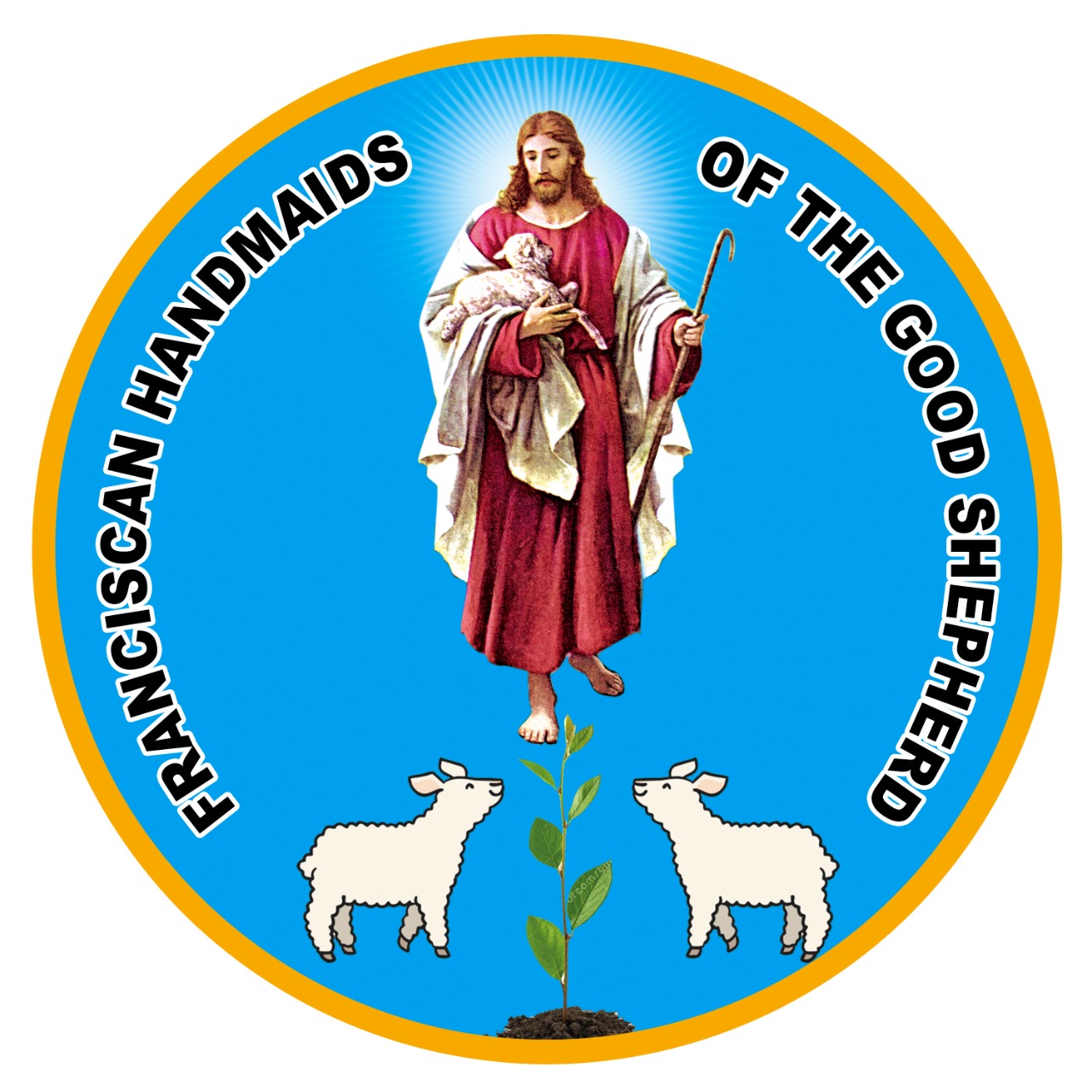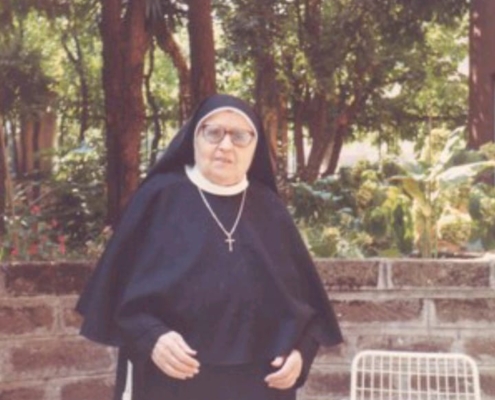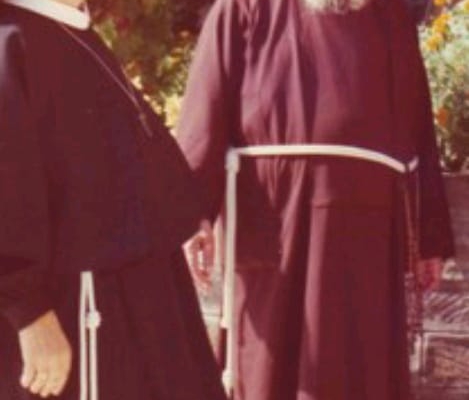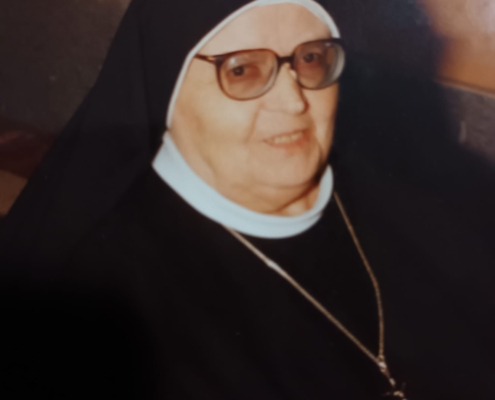Angela Rosa was born to Napoli family in Riziconi(Calabria), Southern Italy on May 12, 1905. Her parents were farmers. As a child, she grew in good character and expressed her earnest desire to work for God. She wanted to join the convent with her elder sister who was in the Congregation of “Daughters of Charity of the Most Precious Blood”. As she was too tender for the austere life, the father refused to give permission. But she remained firm and enthusiastic in a unique way and waited with patience and serenity of heart. By her insistence and with the support of her mother, at the age of fifteen she got the permission and entered the same Congregation at Pagani in Calabria.
After having eighteen months of novitiate, she took the Vows and received the name Sister Teresa. After the Perpetual vows in 1931, she was elected ‘Procurator’ of that convent. She was a person filled with religious fervour and love for Jesus, the Good Shepherd. She had compassionate love and concern for the young girls especially who were living in immorality. So she felt the need to dedicate her life to help these girls and to lead them to right way. In 1934, she was elected as Superior of the community of Montalto Uffugo. After three years she was appointed the Directress of the same institute, as the in-charge of an orphanage for the poor girls. Sister Teresa was directed in the path of St Francis of Assisi by a Franciscan friar who was approached for her spiritual guidance. She took special interest in the spiritual, physical and psychological well-being of the girls entrusted to here and some unpleasant events that happened in the life of them motivated her to live for the cause of these girls.
It so happened that one of the girls who went home for vacation was raped by an unknown man. As per the rule, the orphanage did not allow her to remain there and the family also ignored here completely as the one who destroyed soul and body.
Within two years, an institute was established with more than hundred abandoned children of minor age who were sentby the court and granted by the ministry of grace and justice. So also for the young girls who want to be redeemed from their past lives. The Congregation was expanded from Majerato to Rome. In 1952, the Vicariate of Rome granted the permission to start the same apostolate in the city of Rome. They started the community nella Citta Giardino in via Monte Altissimo. In divine providence the Mother House was shifted to Rome in 1955.
In the history of the Congregation, year 1950 was the time that the Congregation had to face a big challenge. Mother foresaw the great downfall and the shattering of her highest inspiration. There was a breakdown and competitive spirit among the members and faced with questions on the survival of the Congregation. The hierarchy was looking for a right person who can help the Congregation in this difficult moment. Mother Teresa had a good contact with Capuchin priest Fr. Bonaventure of Paullo who could help to face the situation. He was the General Councillor of the Order and former Provincial of Parma and Salerno and the Pontifical Spiritual Assistant for many religious Institutes. He rendered his continuous assistance till the end of his life. It was precisely the reason that on 25th February 1964, the Congregation conferred him the title the “Co – founder” of the institute.
With his paternal love and creative collaboration for the new born Congregation, he guided her towards the Franciscan Spirituality. The Institute took the rule of Third Order Regular, also changed the name to “Franciscan Handmaids of the Good Shepherd”. Father Bonaventure became one of the constructive and precious spiritual guides of the Institute. He was fully imbibing the ideal and spirit of Mother Teresa Napoli at the same time appreciating her will- power accompanied by the docility to the design of our heavenly Father.
Again in another occasion, a girl who as very poor came with an intention to become a nun. Customarily, those who wanted to enter religious life had to bring a substantial amount. Therefore, the authorities asked her to go for work to earn at least some amount of money. She went to work as a servant of a well-known family where she was misused by the only son of the owner while the parents were away. When the parents knew this they blamed her and sent her out mercilessly. She went to the superior and told her all that happened. Sister Teresa felt very sorry for the girl who lost her cherished desire to follow Christ. All such incidents influenced and inspired her to live for the cause of such unwanted and downtrodden women.
As informed to the authorities, the then Bishop and his council accepted unanimously her inspiration and gave her the permission to work for this cause. But she had to undergo lot of challenges and sufferings to give birth to such a new and unique charism in the Church. But she remained in confidence by the spirit of prayer to her beloved one. On 14th May 1938 she began a new Congregation in Catanzaro, South Italy named ” Handmaids of the Good Shepherd” under the legislation of the Archbishop. The new spiritual family was guided by Sister Teresa, in an old building of Ponte Piccolo in Catenzaro.
This was the first struggling point of the new apostolate in the Church. Then the elder sister who was in the same Congregation also wanted to join with her. Many other girls also joined with her and started to work among those women and their new born children. This was one of the main problems in Italy at that time.
Uprooted from via Monte Altissimo the community was thus replanted in a fertile soil of Rome in 1955 that was yet to yield fruits. Meanwhile changes were being brought about by the civil administration. The new rules and regulations gave a serious set back to the educational ventures of Mother Teresa. So also, those who worked for spiritual well-being of the young girls had to adapt certain rules that would not agree with the charism of the congregation. Thus mother Teresa had to suffer a lot and she was obliged to change the apostolate. She was compelled choose another specific aim for the institute. But she was determined to maintain intact the spirit of charity in the new apostolate too.
Led by her singular capacity for intuition which always guided and supported her in moments of crises, Mother Teresa turned her attentionto the service of the aged, adapting to the attitude of “I am the Good Shepherd. The Good Shepherd lays down his life for the sheep “(Jn.10:11).
While she was organizing the Generalate in a new street constructed by the municipality, set apart one portion for a geriatric hospital with modern equipments and appointed medical team.
Within a short span of time the centre became a warm home for those who were abandoned without any hope of life. But the path of progress of the hospital was still a difficult task for Mother Teresa. She had to face lot of obstacles both internal and external. Even in times of adverse local conditions she stood firm and overcame them with her trust in God.
Within two years, an institute was established with more than hundred abandoned children of minor age who were sentby the court and granted by the ministry of grace and justice. So also for the young girls who want to be redeemed from their past lives. The Congregation was expanded from Majerato to Rome. In 1952, the Vicariate of Rome granted the permission to start the same apostolate in the city of Rome. They started the community nella Citta Giardino in via Monte Altissimo. In divine providence the Mother House was shifted to Rome in 1955.
In the history of the Congregation, year 1950 was the time that the Congregation had to face a big challenge. Mother foresaw the great downfall and the shattering of her highest inspiration. There was a breakdown and competitive spirit among the members and faced with questions on the survival of the Congregation. The hierarchy was looking for a right person who can help the Congregation in this difficult moment. Mother Teresa had a good contact with Capuchin priest Fr. Bonaventure of Paullo who could help to face the situation. He was the General Councillor of the Order and former Provincial of Parma and Salerno and the Pontifical Spiritual Assistant for many religious Institutes. He rendered his continuous assistance till the end of his life. It was precisely the reason that on 25th February 1964, the Congregation conferred him the title the “Co – founder” of the institute.
Her vision regarding the congregation did not end with her homeland. She was also interested in the mission apostolate. In1971 she sent her sisters to open a house in Brazil. On 14th September 1977 the Congregation obtained the pontifical bull of approbation from the Sacred Congregation for Religious and Secular Institutes with the apostolic blessing of Pope Paul VI. On an 8th September the Mother realized another important part of her charsim which is to assist the priests who were left like orphans in old age. She opened a house “Casa del Padre” in Puianello (Modena) for the priests who are in old age. On 7th October 1979 the foundress went to Brazil to make her vision successful with the mission of Curitiba. On 18th October 1979 she received the first Indian Vocation in the Congregation at Rome. On 21st March 1980 Mother Teresa returned to Italy filled with enthusiasm for the mission. In the wake of the shortage of vocations in Italy she was determined to open the heart to foreign vocations. As an immediate move, on 11th September, 1981 she contacted Rev. Fr Augustine Kolanchery to send some good aspirants for the religious life from India. With the blessings of H. E. Joseph Cardinal Parecattil, Fr. Antony responded promptly by sending four Indian candidates to the Congregation. This gave her hope and enlightenment to propagate her charism in India too.
On April 21, 1982 the Congregation obtained the juridical recognition. On January 25, 1983 is a memorable day for the Congregation as a small group of sisters were sent to India to start a community at Nedumbassery in the state of Kerala.
Meanwhile, the Mother with the collaboration of Rev. Fr Bonaventure was concluding the works of the constitution. In fact, on 9th June 1984, the Congregation obtained the last approbation from Vatican with the sign of Cardinal Pironio. At present the Congregation Generalate is in Rome, via Gaetano Mazzoni 44. We are working in different parts of the world like Italy, Brazil, India, Philippines, South Korea and Colombia.
On 16th November 1992 Mother Teresa was called for eternal rest. She was declared as Servant of God on 20th April 1999.



